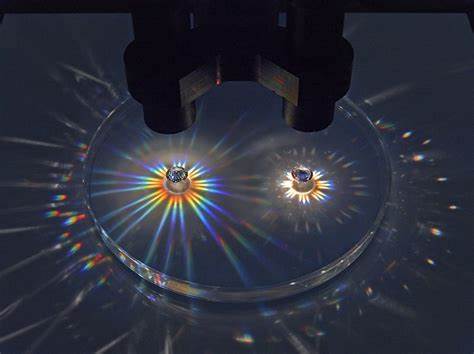
What is Moissanite Exactly
Share
The Allure of Moissanite
Moissanite, a gemstone known for its incredible brilliance and fire, has rapidly become a popular alternative to diamonds in the world of jewelry. This dazzling gem is not only visually stunning but also offers several benefits that make it a compelling choice for many. In this blog post, we'll delve into the fascinating world of moissanite, exploring its origins, properties, and why it might be the perfect choice for your next piece of jewelry.
The Origin Story
Moissanite was first discovered in 1893 by French scientist Henri Moissan in a crater created by a meteorite in Arizona. Initially, it was mistaken for diamonds due to its similar appearance. However, further analysis revealed that this gemstone was composed of silicon carbide, a compound that is incredibly rare in nature. Today, most moissanite used in jewelry is lab-created, ensuring its availability and affordability.

Unique Properties of Moissanite
- Brilliance and Fire: Moissanite is renowned for its exceptional brilliance, which is the gemstone's ability to reflect light. It also exhibits a high level of fire, the dispersion of light into its spectral colors. These properties give moissanite a sparkle that often surpasses that of diamonds.
- Hardness and Durability: On the Mohs scale of hardness, moissanite scores a 9.25, making it the second hardest gemstone after diamonds. This makes it highly resistant to scratching and suitable for everyday wear.
- Cost-Effective: Moissanite is significantly more affordable than diamonds of similar size and quality. This allows individuals to choose larger or higher quality stones without breaking the bank.
- Ethical and Sustainable: As a lab-created gemstone, moissanite offers an ethical alternative to diamonds, which can sometimes be associated with environmental and human rights issues. Choosing moissanite means supporting sustainable and conflict-free practices.

Comparing Moissanite and Diamonds
While moissanite and diamonds share many similarities, there are key differences that set them apart:
- Appearance: Both gems are visually stunning, but moissanite has more fire and brilliance than diamonds that displays flashes of rainbow colors. This play of light might be more captivating for those seeking a truly eye-catching gemstone.
- Value: Cost is a significant advantage for moissanite. They are considerably less expensive than mined or lab grown diamonds, making them attractive alternatives. Both simulated diamonds and moissanite offer peace of mind when it comes to ethical considerations. They are conflict-free alternatives to traditional diamonds, ensuring your dazzling piece wasn’t sourced through unethical mining practices.
- Choice and Variety: Moissanite comes in a variety of shapes and sizes, allowing for greater flexibility in jewelry design. Lab-created diamonds are also available but are typically more expensive than moissanite.
Why Choose Moissanite?
Moissanite is an excellent choice for those looking for a beautiful, durable, and ethically sourced gemstone. Whether you're searching for an engagement ring, a pair of stunning earrings, or a statement necklace, moissanite offers a brilliant and affordable option. Its unique properties and ethical advantages make it a standout choice for modern jewelry enthusiasts.
Caring for Your Moissanite Jewelry
Caring for moissanite is simple. Regular cleaning with mild soap, water, and a soft brush will keep your gemstone sparkling. Avoid harsh chemicals and extreme temperatures, and store your moissanite jewelry separately to prevent scratches.

Conclusion
Moissanite is more than just an alternative to diamonds; it is a gemstone with its own unique charm and advantages. Its brilliance, durability, affordability, and ethical production make it a compelling choice for anyone seeking beautiful and responsible jewelry. Explore the world of moissanite and discover a gem that truly stands out in every way.
